SOMETHINGS FOR THE NOSE, THE EYES, AND THE TASTEBUDS
Makes a Lot of Scents
Many years ago, at this time of the year, I was hiking in the nearby Shawangunk Mountains, in Minnewaska State Park, when a most delectable, spicy-sweet aroma wafted past my nose. I followed my nose off the trail and into the woods. After stepping over and around fallen stumps in boggy soil and ducking under low-hanging branches, I came upon the source of that aroma: the white flowers of a large swamp azalea (Rhododendron viscosum).
Last night as I lay in the comfort of my bed and was about to drift off to sleep, that very same scent drifted into the open bedroom window. I immediately knew the source of that aroma: a swamp azalea that I had planted in a bed along the north side of my home back in 2006.
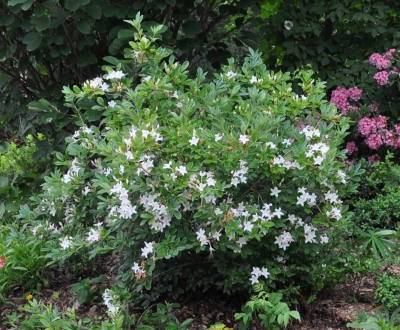
My yard is obviously quite a different habitat from that of Minnewaska woods, and especially where that wild swamp azalea grew. Besides shade and moist ground, that forested site‘s soil is very acidic, relatively poor in nutrients, and rich in humus.
The bed near my window emulates those conditions. It’s on the north side of the house, so it’s partially shaded. I added sulfur, a naturally mined mineral, to bring the pH down to about 5. I dug in abundant sawdust to build up humus in the soil, and mulch each year with more sawdust or autumn leaves to maintain it. Drip irrigation tubes running through the bed automatically provide daily watering to maintain a moist soil.
Besides aroma, swamp azalea doesn’t have much going for it. The plant is deciduous, so fades out of view in winter. I’ve read that fall leaf color can be very nice, but never noticed it. The white flowers are nice enough, but nothing spectacular to look at. For me, this plant is all about scent.
The Family is Invited
Scent alone from one swamp azalea plant wouldn’t justify drip irrigation, annual mulching, and periodic additions of sulfur. So that bed near my bedroom window was developed as a home also for other plants that enjoy the same special soil conditions as swamp azalea. Mostly, these are plants in the heath family (Ericaceae), which includes blueberry, lingonberry, mountain laurel, rhododendron, other kinds of azaleas, and, of course, heath and heather.
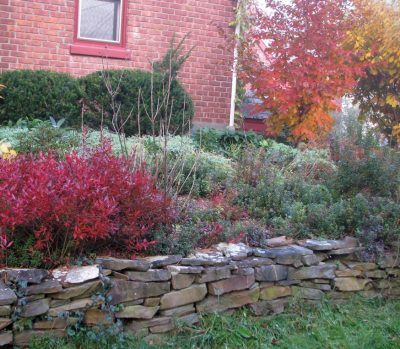
Most of the above family members are growing in that bed. Right after the swamp azalea blossoms wave goodbye for the season, lowbush blueberries begin ripening, then huckleberries, and then lingonberries. Earlier in the season, rich red or lily white ornamental rhododendron blossoms were followed by mountain laurel blossoms, which finished blooming a couple of weeks ago.
Even beyond blossoms and fruits, this bed offers a visual symphony of harmonies and contrasts. The rhododendrons and mountain laurels are mostly dwarf varieties that are 3 foot high mounds of glossy greenery year-round. The lingonberries and lowbush blueberries knit together everything right at ground level, both plants spreading via underground runners to intertwine for a dense ground cover. In fall, blueberry’s crimson leaves and then, through winter, its reddish stems, contrast pleasantly with lingonberry’s mouse-ear-sized, evergreen leaves and red, pea-sized berries.
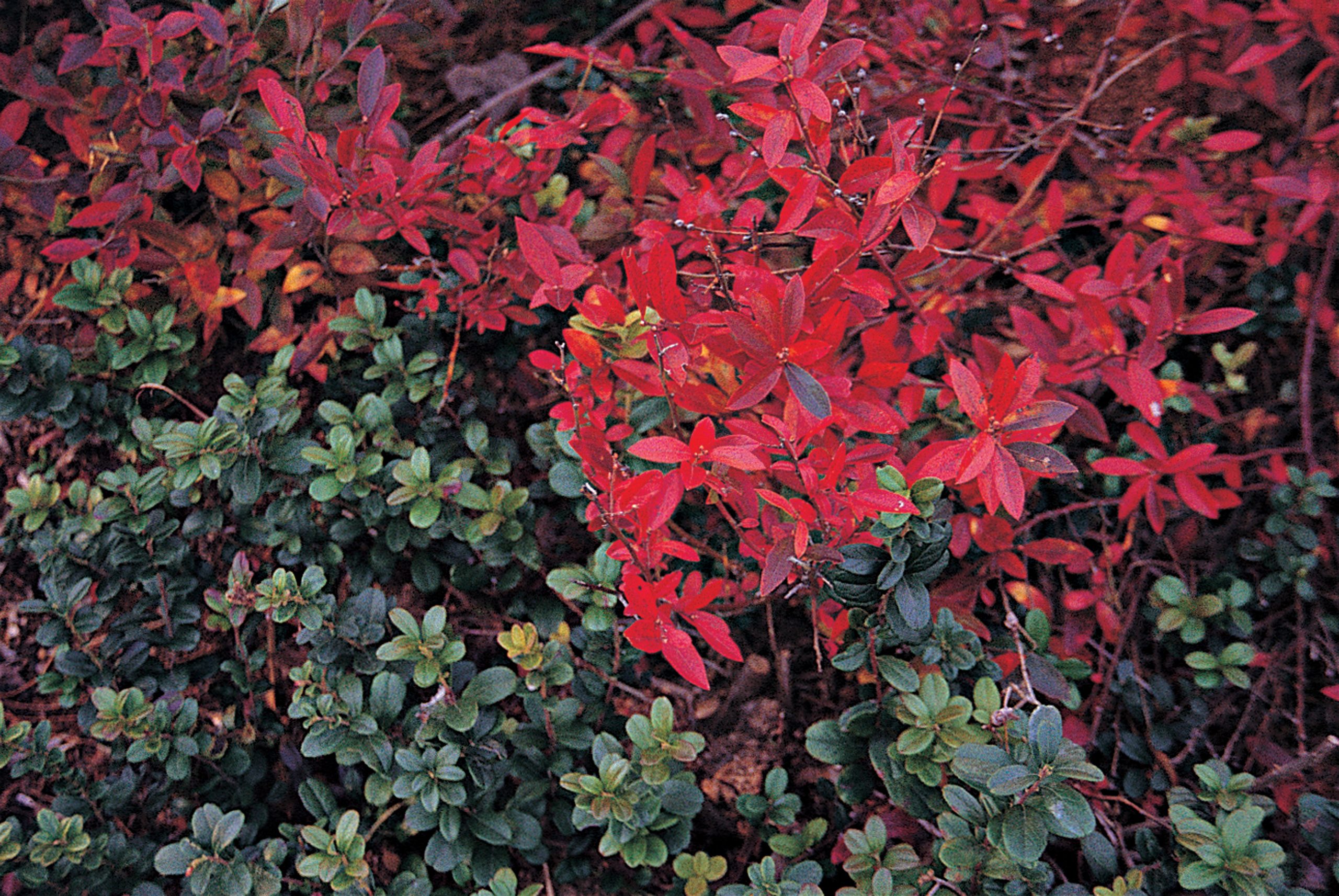
Lingonberry and lowbush blueberry in fall
The lingonberries need not be picked as soon as they ripen because they’ll hang in good visual and gustatory condition for many months.
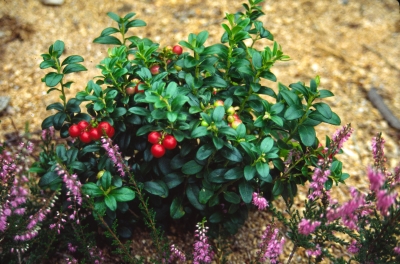 I’ve invited a few non-family members into the bed. Most notable are a witchhazel that’s covered in fragrant, yellow blossoms in late winter and a stewartia that is now spreading open the white petals of its camellia-like blossoms.
I’ve invited a few non-family members into the bed. Most notable are a witchhazel that’s covered in fragrant, yellow blossoms in late winter and a stewartia that is now spreading open the white petals of its camellia-like blossoms.
Still Planting Vegetables
A friend has a new vegetable garden which she has been planting all spring. She has two beds not yet planted and asked me if and what she could still plant there for this season. “Plenty,” I told her.
For starters, how about a late crop of bush beans and/or zucchini? Bush beans start to peter out after bearing for a couple of weeks, which is why I make 3 plantings each season, the first in the middle of May.
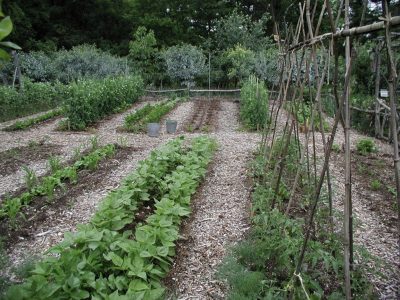
The same goes for cucumbers, which in a few weeks usually succumb to bacterial wilt. Two plantings, the second sown about now, often do the trick to keep the cukes a comin’. Here on the farmden, the varieties Shintokiwa and Little Leaf H-19 seem better able to fend off pests than other varieties I’ve grown. Also, to a lesser extent, the variety Suhyo (sometimes spelt Suyo).
And, of course, zucchini or any other summer squash. Zucchini typically succumbs to borers or mildew by midsummer; a fresh planting keeps zucchini coming on all season long. One caution is not to plant too much zucchini! Any more than a few plants and you’ll be forced to come up with concoctions such as zucchini bread to use up the excess.
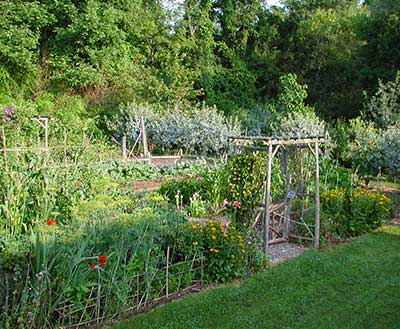


Your garden is lovely! I’m trying 3 plantings of cucumbers and zucchini this year. I’ve never tried drip irrigation. We have very hard water, and I was afraid of clogging. Is your water hard? Do you know if this would be a problem? Can I make an economical drip system myself without having to buy a lot of expensive stuff?
The reliable way to deal with the hard water is with some system than injects acid into the water, or by running the water through a water softener. Beyond that, drip isn’t particularly expensive, and especially not when you consider its benefits.
I had a swamp azalea, then the deer destroyed it.